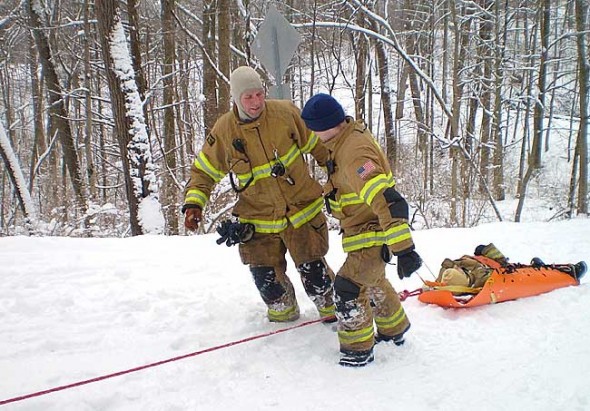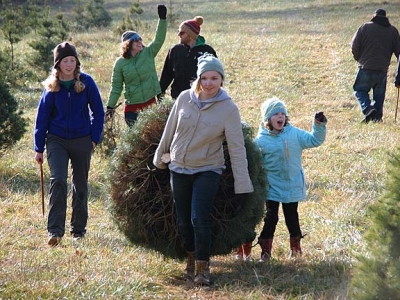Seek the fire-and-rescue life?
- Published: May 5, 2011
Alex Wendt came to Miami Townsip Fire-Rescue to do something to serve the community and because he wanted to see what the life of a firefighter was about. A student at Wittenburg at the time, he hoped to go to law school after graduation. A little over a year later, he is now a level I firefighter and EMS trainee and is planning to become a paramedic and pursue a degree in fire science.
“I was interested in being a volunteer fire fighter, and I ended up falling in love with the fire service,” Wendt said last week in an interview at the fire station on Corry Street. “I realized it was a lot cooler to be a fire fighter, and I chose it as a career path.”
Wendt’s story is not surprising to Fire Chief Colin Altman, who knows that once volunteers complete the training and commit to serving on the local squad, they are very dedicated to the job and find both the camaraderie and the community interaction very rewarding. But for a host of reasons, recently the fire department hasn’t been attracting as many volunteers as Altman would like. While the department can manage a roster of up to 60 cross-trained volunteers, the Fire-Rescue squad currently consists of 38 volunteers, 34 of whom are able to respond to EMS calls, and fewer of whom are trained as firefighters. In addition to low overall numbers, many of the core volunteers live outside Miami Township, which makes response times slower and can sometimes compromise the emergency response effort, Altman said.
The fire department wants to recruit new members to its team of emergency responders, and is appealing especially to women and men who live inside the township. The service requires 32 hours of on-call time per month, plus about eight to 16 hours of training to maintain skills with fire and medical response procedures. It’s a more intense commitment than some other types of volunteering, which is partly why volunteers are reimbursed a nominal amount per call they respond to, Altman said. But the most attractive part of the job is the opportunity to serve the community and engage with a professional and highly skilled emergency management team at times of crisis and critical need, he said.
Oddly, at a time of nationally low volunteerism, many fire departments in the surrounding area, particularly those that hire professional firefighters, carry waiting lists for volunteers who want to serve, Altman said. But volunteer fire departments have a long history, dating back to Roman times when bucket brigades of 500 men would unite to fight fires. Benjamin Franklin founded one of the country’s first volunteer departments, according to Bruce Laurie’s Working People of Philadelphia, made up of “town leaders and businessmen who saw community service as part of their day.” In Germany most fire departments are run by volunteers, called “freiwillige feuerwehr,” and in the U.S., 71 percent of firefighters are volunteers, according to the National Fire Protection Association.
While Miami Township benefits from the volunteers it draws from Xenia, Beavecreek, Springfield and other areas of low demand for volunteer firefighters, the local department still has a need for more local responders, Altman said. Though Yellow Springs was built on a legacy of community service, Altman guesses that Yellow Springs residents do so much volunteering to staff the dozens of nonprofit organizations in town that few have the time to commit to the demanding schedule of a fire volunteer.
To be an EMT, volunteers need 160 hours of advanced first aid and basic cardiac and trauma response training, which the fire department offers free of charge over a period of four months, Altman said. Ideally, it helps if volunteers are cross-trained for fire fighting as well, and that class requires about 120 hours of training several nights a week at the fire station and in the field practicing controlled burns. Once volunteers are trained, the call schedule itself can also be quite demanding, though volunteers can schedule themselves according to their availability.
Fire fighting wasn’t something Kris Collins envisioned herself doing when she and her family moved to Yellow Springs in 2005. She had helped with adult literacy in Detroit, and though she wanted to volunteer in the community here, she was intimidated by the time commitment needed to be a fire volunteer, she said in an interview last week. But after two years of consideration, she finally joined the squad, and has found that the intense training and demands of the service have given her indispensible skills that have allowed her to feel immensely useful to her community in times of greatest need.
“I didn’t know anything about fire fighting and would never have thought of myself in this role,” said Collins, 43, who is now an advanced life support technician, fire fighter, part-time Miami Township Fire-Rescue employee, and president of the Miami Township Fire Association. “I find it to be very empowering, and I’m having fun doing it.”
After seeing how much fun Kris was having, the whole Collins family has now joined the squad, including her husband, Dave, and their son, Carter, who is a junior Explorer with the department. Dave manages his service with a full-time job in Dayton by informing his boss every month of his volunteer schedule, and relying on the fact that Ohio law prohibits the disciplining of an employee for being late to work because of issues related to their service as a fire-rescue volunteer.
Being an emergency responder has pushed Collins to step up and do things she wasn’t always comfortable doing, but she remembers the exhilaration of being able to work quickly with a team to save someone’s life. On one call in July 2009 involving a head-on collision, she approached the situation as a fire fighter, helping to extinguish a fire in one vehicle and cut free a man entrapped in another vehicle. Then she became a medic and helped to treat the patient and transport him to a hospital. It involved a lot of communication between volunteers and squads from other departments, and she didn’t know many of the people she was working with or their skill levels, but they functioned well as a volunteer squadron to rescue the victim and resolve the problem, she said.
That feeling of being part of a team or family is a tradition with the fire service and it comes with the territory, according to Chris Kitts, Miami Township fire sergeant and part-time employee, and Fire-Rescue volunteer Kenny Rust in an interview last week. Fire fighters are called to help others at their worst through sometimes dangerous incidents, and they rely on each other to make sure both the victim and the rest of the crew escapes without harm. Even when they don’t know each other yet, they know they would risk their lives to save one another.
“I might have no idea who Kenny Rust was before he came here, but I have to rely on him in a fire — he’s my eyes, and if I go down, he’s the one who’s going to save me,” Kitts said.
One squad member did lose consciousness in the basement of a house that caught fire last year, Kitts recalled. “That’s one of us — that’s pretty big.’
Rust agreed that the strong sense of camaraderie is one of the reasons he felt compelled to join the department here.
“It’s nice to know that they got my back, and I got their back,” he said.
Though the Township fire department is managing its shifts with the current volunteer roster, the department is having to rely more heavily on paid staff, including Altman, Assistant Fire Chief Denny Powell, Collins and two other part-time employees to cover night-time and weekend calls, Collins said. And fewer people are available to respond to some calls that require a bigger team of people to handle properly. A cardiac arrest call, for instance, ideally would involve at least six responders: one dedicated to keeping the patient’s airway open, two or three to trade-off on chest compressions, one to start an IV and begin cardiac medications, one to record symptoms and times medications were administered, and one or two more people to interview bystanders, get medical history and talk to family members to keep them calm.
“On those calls there’s a lot going on, and it’s happening quickly,” Collins said. The more people who respond to their pagers for the call, the more effective the team can be in doing the job. Sharing the responsibility and the long hours with a greater number of people helps to prevent burn-out of any one individual, she said. “The whole basis of volunteerism is that you come whenever you can and help build that support system.”
Miami Township is starting a new Fire I class on June 2, and new members are invited to sign up now to begin training. Those who wish to support the department in other ways can pick up a yard sign at the fire station advertising the need for more volunteers.
One Response to “Seek the fire-and-rescue life?”
The Yellow Springs News encourages respectful discussion of this article.
You must login to post a comment.
Don't have a login? Register for a free YSNews.com account.















It’s great to see people like this that are passionate about their careers and volunteer to help out their communities. First responders like this go through all the necessary training and some even take a rescue class to be properly trained for their position.